
Concept explainers
(a)
Interpretation:
The product formed when
Concept Introduction:
Pyridine is a heterocyclic compound which contains nitrogen atom. Pyridine nitrogen atom contain a lone pair. The lone pair of pyridine is not involved in the resonance with the
Answer to Problem 26.27AP
The product formed when
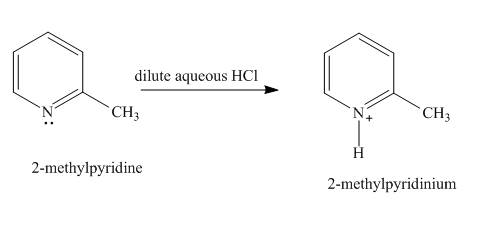
Explanation of Solution
In the given compound, the lone pair of the pyridine nitrogen is not involved in the resonance with the ring. Pyridine acts as base in the presence of acid. The nitrogen abstracts the proton from acid. The product formed is

Figure 1
The product formed in the given reaction is
(b)
Interpretation:
The product formed when
Concept Introduction:
Pyridine is a heterocyclic compound which contains nitrogen atom. Pyridine nitrogen atom contain a lone pair. The lone pair of pyridine is not involved in the resonance with the aromatic ring. No delocation of electron takes place, hence pyridine acts as a base. The hydrogen atoms of pyridine ring are not highly acidic, so mild base can’t abstract proton from pyridine. It requires a strong base for abstraction of proton.
Answer to Problem 26.27AP
No reaction takes place when
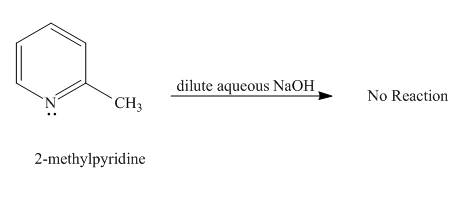
Explanation of Solution
Protons of pyridine are not highly acidic in nature. Sodium hydroxide cannot abstract proton from pyridine. It requires a very strong base for the removal of proton from pyridine to takes place. Hence, no reaction takes place between

Figure 2
No product is formed in the given reaction.
(c)
Interpretation:
The product formed when
Concept Introduction:
Pyridine is a heterocyclic compound which contains nitrogen atom. Pyridine nitrogen atom contain a lone pair. The lone pair of pyridine is not involved in the resonance with the aromatic ring. No delocation of electron takes place, hence pyridine acts as a base. The hydrogen atoms of pyridine ring are not highly acidic, so mild base can’t abstract proton from pyridine. It requires a strong base for abstraction of proton.
Answer to Problem 26.27AP
The product formed when

Explanation of Solution
The butyl-lithium compound is a very strong base. It will abstract proton from the methyl group of

Figure 3
The product formed in the given reaction is
(d)
Interpretation:
The product formed when
Concept Introduction:
Nitration reaction is aromatic electrophilic substitution reaction. The nitrating mixture contains nitric acid and sulfuric acid. The nitrosonium ion is formed as electrophile. The methyl group is an activating group, so it promotes electrophilic substitution reaction at ortho-para position.
Answer to Problem 26.27AP
The product formed when

Explanation of Solution
The compound

Figure 4
The product formed in the given reaction is
(e)
Interpretation:
The product formed when
Concept Introduction:
Pyridine is a heterocyclic compound which contains nitrogen atom. Pyridine nitrogen atom contain a lone pair. The lone pair of pyridine is not involved in the resonance with the aromatic ring. Hydrogen peroxide is a strong oxidizing agent. It will oxidize the nitrogen atom of pyridine to form
Answer to Problem 26.27AP
The product formed when

Explanation of Solution
Hydrogen peroxide is an oxidizing agent. It will oxidize the given compound. The oxidation reaction takes place at the nitrogen atom.

Figure 5
The product formed in the given reaction of
(f)
Interpretation:
The product formed when
Concept Introduction:
Pyridine is a heterocyclic compound which contains nitrogen atom. Pyridine nitrogen atom contain a lone pair. The lone pair of pyridine is not involved in the resonance with the aromatic ring. No delocation of electron takes place, hence pyridine acts as a base. The nitrogen atom lone pair attacks the methyl group of methyl iodide.
Answer to Problem 26.27AP
The product formed when
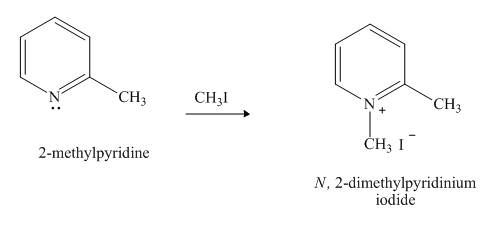
Explanation of Solution
The lone pair of nitrogen atom of pyridine is not involved in the resonance with the aromatic ring. The lone pair makes the pyridine compound basic in nature. When compound

Figure 6
The product formed in the given reaction of
(g)
Interpretation:
The product formed when
Concept Introduction:
Pyridine is a heterocyclic compound which contains nitrogen atom. Pyridine nitrogen atom contain a lone pair. The lone pair of pyridine is not involved in the resonance with the aromatic ring. No delocation of electron takes place, hence pyridine acts as a base. Lithiated pyridine compound reacts with
Answer to Problem 26.27AP
The product formed when
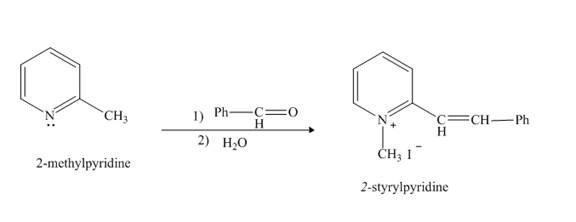
Explanation of Solution
The lithiation product formed reacts with benzaldehyde, nucleophilic addition reaction takes place to form

Figure 7
The product formed when
(h)
Interpretation:
The product formed when
Concept Introduction:
Pyridine is a heterocyclic compound which contains nitrogen atom. Pyridine nitrogen atom contain a lone pair. The lone pair of pyridine is not involved in the resonance with the aromatic ring. Hydrogen peroxide is a strong oxidizing agent. It will oxidize the nitrogen atom of pyridine to form
Answer to Problem 26.27AP
The product formed when
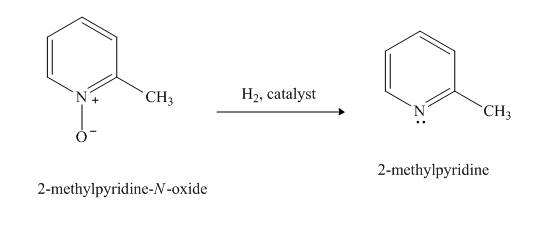
Explanation of Solution
The compound

Figure 8
The product formed when
Want to see more full solutions like this?
Chapter 26 Solutions
ORGANIC CHEM +SG +SAPLING >IP<
- Draw the structure of serine at pH 6.8. Click and drag to start drawing a structure. : d كarrow_forwardTake a look at this molecule, and then answer the questions in the table below it. CH2OH H H H OH OH OH CH2OH H H H H OH H H OH H OH Is this a reducing sugar? yes α β ロ→ロ no ☑ yes Does this molecule contain a glycosidic bond? If you said this molecule does contain a glycosidic bond, write the symbol describing it. O no 0+0 If you said this molecule does contain a glycosidic bond, write the common names (including anomer and enantiomer labels) of the molecules that would be released if that bond were hydrolyzed. If there's more than one molecule, separate each name with a comma. ☐arrow_forwardAnswer the questions in the table below about this molecule: H₂N-CH₂ -C—NH–CH–C—NH–CH—COO- CH3 CH CH3 What kind of molecule is this? 0= CH2 C If you said the molecule is a peptide, write a description of it using 3-letter codes separated ☐ by dashes. polysaccharide peptide amino acid phospolipid none of the above Хarrow_forward
- Draw a Haworth projection of a common cyclic form of this monosaccharide: CH₂OH C=O HO H H -OH H OH CH₂OH Click and drag to start drawing a structure. : ☐ Х S '☐arrow_forwardNucleophilic Aromatic Substitution 22.30 Predict all possible products formed from the following nucleophilic substitution reactions. (a) (b) 9 1. NaOH 2. HCI, H₂O CI NH₁(!) +NaNH, -33°C 1. NaOH 2. HCl, H₂Oarrow_forwardSyntheses 22.35 Show how to convert toluene to these compounds. (a) -CH,Br (b) Br- -CH3 22.36 Show how to prepare each compound from 1-phenyl-1-propanone. 1-Phenyl-1-propanone ہتی. Br. (b) Br (racemic) 22.37 Show how to convert ethyl benzene to (a) 2,5-dichlorobenzoic acid and (b) 2,4-dichlorobenzoic acid. 22.38 Show reagents and conditions to bring about the following conversions. (a) 9 NH2 8 CO₂H NH2 CO₂Et (d) NO2 NH2 S NH₂ NO2 CHS CHarrow_forward
- ive the major organic product(s) of each of the following reactions or sequences of reactions. Show all rant stereochemistry. [10 only] A. B. NaN3 1. LiAlH4, ether Br 2. H₂O CH3 HNO3 H₂/Pt H₂SO ethanol C. 0 0 CH3CC1 NaOH NHCCH AICI H₂O . NH₂ CH3CH2 N CH2CH3 + HCI CH₂CH 3 1. LIAIH, THE 2. H₂Oarrow_forwardCalculate the stoichiometric amount of CaCl2 needed to convert all of the CuSO4 into CuCl2.arrow_forwardH CH تنی Cl 1. NaCN, DMF 2. LIAIH4, ether H₂O pyridine N NH₂ 5 CH H 1 HNO, H₂SO 2. Nal NH2 Br Br HNO₂ CuCl H₂SO HCI CH3 H3C NN HSO KCN CuCN 1. HNO₂, H₂SO O₂N NH2 2. OH ཀ་ལས། །ས་ཅན་ :i་དེ་མ་མ་སེ་ NH₂ CH3 1. HNO₂, H₂SO4 2. H3PO₂ 1 HNO2, H2SO4 2. Nalarrow_forward
- ive the major organic product(s) of each of the following reactions or sequences of reactions. Show all rant stereochemistry. [10 only] A. B. NaN3 1. LiAlH4, ether Br 2. H₂O CH3 HNO3 H₂/Pt H₂SO ethanol C. 0 0 CH3CC1 NaOH NHCCH AICI H₂O . NH₂ CH3CH2 N CH2CH3 + HCI CH₂CH 3 1. LIAIH, THE 2. H₂Oarrow_forwardIf a pharmacy chain sold 65 million 500-mg tablets of aspirin, how many US tons of aspirin does this represent? Report your answer to 2 significant figures.arrow_forwardHere are the options: reducing a monosaccharide a non reducing disaccharide amylopectin cellulose 1,4' beta- glycosidearrow_forward
 Chemistry: Principles and ReactionsChemistryISBN:9781305079373Author:William L. Masterton, Cecile N. HurleyPublisher:Cengage Learning
Chemistry: Principles and ReactionsChemistryISBN:9781305079373Author:William L. Masterton, Cecile N. HurleyPublisher:Cengage Learning

